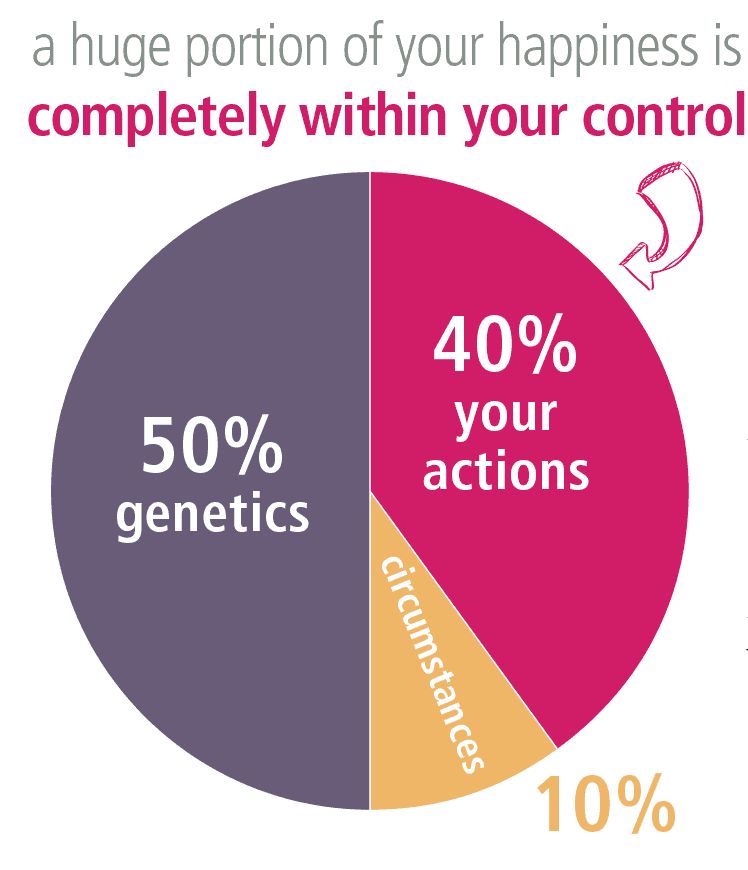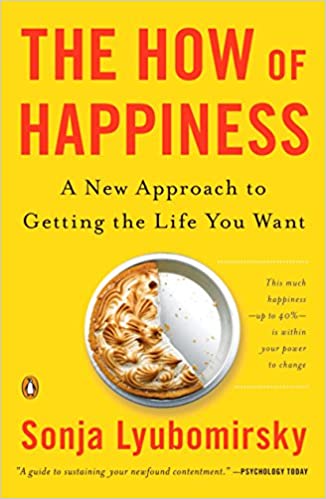The How of Happiness by Sonja Lyubomirsky
The Book in 1 Sentences
The How of Happiness: A New Approach to Getting the Life You Want
“All of us want to be happy, even if we don’t admit it openly or choose to cloak our desire in different words. Whether our dreams are about professional success, spiritual fulfillment, a sense of connection, a purpose in life, or love and sex, we covet those things because ultimately we believe that they will make us happier.
Yet few of us truly appreciate just how much we can improve our happiness or know precisely how to go about doing it. To step back and consider your deep-seated assumptions about how to become a happier person and whether it’s even possible for you—what I hope this book will spur you to do—is to understand that becoming happier is realizable, that it’s in your power, and that it’s one of the most vital and momentous things that you can do for yourself and for those around you.” ~ Sonja Lyubomirsky
5 BIG Ideas
1. 40% of happiness is in our hands!
2. “If you’re not happy today, then you won’t be happy tomorrow unless you take things into your own hands and take action.”
3. The 12 happiness activities.
4. “The more a person is inclined to gratitude, the less likely he or she is to be depressed, anxious, lonely, envious, or neurotic.”
5. “Find a happy person, and you will find a project.”
The How of Happiness Book Summary
1. Happiness By-products
“In sum, across all the domains of life, happiness appears to have numerous positive by-products that few of us have taken the time to really understand.
In becoming happier, we not only boost experiences of joy, contentment, love, pride, and awe but also improve other aspects of our lives: our energy levels, our immune systems, our engagement with work and with other people, and our physical and mental health.
In becoming happier, we bolster as well our feelings of self-confidence and self-esteem; we come to believe that we are worthy human beings, deserving of respect.
A final and perhaps least appreciated plus is that if we become happier, we benefit not only ourselves but also our partners, families, communities, and even society at large.”
2. The 40% in Our Hands!
“In a nutshell, the fountain of happiness can be found in how you behave, what you think, and what goals you set every day of your life. ‘There is no happiness without action.’
If feelings of passivity and futility overcome you whenever you face up to your happiness set point or to your circumstances, you must know that a genuine and abiding happiness is indeed within your reach, lying within the 40 percent of the happiness pie chart that’s yours to guide.”

Through remarkable studies with identical twins separated at birth, scientists have discovered that:
- About 50% of our happiness is determined by our genetics and that we have what they call a “happiness set point”—a level of happiness we tend to gravitate toward.
- 10% of our happiness determined by our life circumstances.
- And the 40%: “What makes up this 40 percent? Besides our genes and the situations that we confront, there is one critical thing left: our behavior.
Thus the key to happiness lies not in changing our genetic makeup (which is impossible) and not in changing our circumstances (i.e., seeking wealth or attractiveness or better colleagues, which is usually impractical), but in our daily intentional activities.
With this in mind, our pie chart illustrates the potential of the 40 percent that is within our ability to control, the 40 percent for room to maneuver, for opportunities to increase or decrease our happiness levels through what we do in our daily lives and how we think.”
Sonja also says that “If an unhappy person wants to experience interest, enthusiasm, contentment, peace, and joy, he or she can make it happen by learning the habits of a happy person.”
3. Happiness Work
“It may be obvious that to achieve anything substantial in life—learn a profession, master a sport, raise a child—a good deal of effort is required. But many of us find it difficult to apply the notion of effort to our emotional or mental lives.
Without effort, we might ‘get lucky,’ but like a long-forgotten New Year’s resolution, the success will be short-lived. Consider how much time and commitment many people devote to physical exercise, whether it’s going to the gym, jogging, kickboxing, or yoga.
My research reveals that if you desire greater happiness, you need to go about it in a similar way. In other words, becoming lastingly happier demands making some permanent changes that require effort and commitment every day of your life. Pursuing happiness takes work, but consider that this ‘happiness work’ may be the most rewarding work you’ll ever do.”
And remember that “If you’re not happy today, then you won’t be happy tomorrow unless you take things into your own hands and take action.”
4. 12 Happiness Activities
There are 12 Happiness Activities that'd been scientifically proven to boost our happiness levels:
1. Expressing Gratitude
2. Cultivating Optimism
3. Avoiding Overthinking and Social Comparison
4. Practicing Acts of Kindness
5. Nurturing Social Relationships
6. Developing Strategies for Coping
7. Learning to Forgive
8. Increasing Flow Experiences
9. Savoring Life’s Joys
10. Committing to Your Goals
11. Practicing Religion and Spirituality
12. Taking Care of Your Body: Meditation + Physical Activity + Acting Like a Happy Person
“If you want to reap long-term emotional benefits from a happiness activity, you need to devote persistent effort. Of course, if you identify with and enjoy what you are doing, you’ll be more energized and committed.”
5. Expressing Gratitude
“People who are consistently grateful have been found to be relatively happier, more energetic, and more hopeful and to report experiencing more frequent positive emotions.
They also tend to be more helpful and empathic, more spiritual and religious, more forgiving, and less materialistic than others who are less predisposed to gratefulness.
Furthermore, the more a person is inclined to gratitude, the less likely he or she is to be depressed, anxious, lonely, envious, or neurotic.”
It is found that people who kept a weekly gratitude journal for 10 weeks in which they noted five things for which they were thankful were significantly happier than those who didn’t.
So, get a weekly gratitude journal and start writing down what you’re thankful for… 🙂
6. Cultivating Optimism
“Write down your barrier thoughts, and then consider ways to reinterpret the situation. In the process, ask yourself questions like… What else could this situation or experience mean? Can anything good come from it? Does it present any opportunities for me? What lessons can I learn and apply to the future? Did I develop any strengths as a result?”
“Essentially, all optimism strategies involve the exercise of construing the world with a more positive and charitable perspective, and many entail considering the silver lining in the cloud, identifying the door that opens as a result of one that has closed.
It takes hard work and a great deal of practice to accomplish effectively, but if you can persist at these strategies until they become habitual, the benefits could be immense. Some optimists may be born that way, but scores of optimists are made with practice.”
And remember that “All that is required to become an optimist is to have the goal and to practice it. The more you rehearse optimistic thoughts, the more ‘natural’ and ‘ingrained’ they will become. With time they will be part of you, and you will have made yourself into an altogether different person.”
7. Building Optimism Muscle!
“There are many ways to practice optimism, but the one that has been empirically shown to enhance well-being is the original Best Possible Selves diary method.
To try it out, sit in a quiet place, and take twenty to thirty minutes to think about what you expect your life to be one, five, or ten years from now.
Visualize a future for yourself in which everything has turned out the way you’ve wanted. You have tried your best, worked hard, and achieved all your goals.
Now write down what you imagine. This writing exercise in a sense puts your optimistic ‘muscles’ into practice. Even if thinking about the brightest future for yourself doesn’t come naturally at first, it may get there with time and training. Amazing things can come about as a result of writing.”
8. Avoiding Overthinking
“The combination of rumination and negative mood is toxic. Research shows that people who ruminate while sad or distraught are likely to feel besieged, powerless, self-critical, pessimistic, and generally negatively biased.”
So, how to deal with that?
Sonja says: “I have found that truly happy people have the capacity to distract and absorb themselves in activities that divert their energies and attention away from dark or anxious ruminations.”
And remember that: “If you are someone plagued by ruminations, you are unlikely to become happier before you can break that habit.”
9. Avoid Social Comparison
“We found that the happiest people take pleasure in other people’s successes and show concern in the face of others’ failures. A completely different portrait, however, has emerged of a typical unhappy person—namely, as someone who is deflated rather than delighted about his peers’ accomplishments and triumphs and who is relieved rather than sympathetic in the face of his peers’ failures and undoings.”
How about you? Are you celebrating other people’s successes?
A scientific fact: “You can’t be envious and happy at the same time. People who pay too much attention to social comparisons find themselves chronically vulnerable, threatened, and insecure.”
And: “The happier the person, the less attention she pays to how others around her are doing.”
10. Increasing Flow Experiences
“In 1932, weighed down by the sorrows and agonies of his self-absorbed and aimless clients, an Australian psychiatrist named W. Béran Wolfe summed up his philosophy like this:
‘If you observe a really happy man you will find him building a boat, writing a symphony, educating his son, growing double dahlias in his garden, or looking for dinosaur eggs in the Gobi Desert.’
He was right. People who strive for something personally significant, whether it’s learning a new craft, changing careers, or raising moral children, are far happier than those who don’t have strong dreams or aspirations. Find a happy person, and you will find a project.”
“... working toward a meaningful life goal is one of the most important strategies for becoming lastingly happier.”
“It turns out that the process of working toward a goal, participating in a valued and challenging activity, is as important to well-being as its attainment.”
10. Take Care of Your Body
“An impressive study of physical activity was published in the Archives of Internal Medicine in 1999. The researchers recruited men and women fifty years old and over, all of them suffering from clinical depression, and divided them randomly into three groups.
The first group was assigned to four months of aerobic exercise, the second group to four months of antidepressant medication (Zoloft), and the third group to both.
The assigned exercise involved three supervised forty-five-minute sessions per week of cycling or walking/jogging at moderate to high intensity.
Remarkably, by the end of the four-month intervention period, all three groups had experienced their depressions lift and reported fewer dysfunctional attitudes and increased happiness and self-esteem.
Aerobic exercise was just as effective at treating depression as was Zoloft, or as a combination of exercise and Zoloft. Yet exercise is a lot less expensive, usually with no side effects apart from soreness.
Perhaps even more remarkably, six months later, participants who had “remitted” (recovered) from their depressions were less likely to relapse if they had been in the exercise group (six months ago!) than if they had been in the medication group.”
“No one in our society needs to be told that exercise is good for us. Whether you are overweight or have a chronic illness or are a slim couch potato, you’ve probably heard or read this dictum countless times throughout your life. But has anyone told you—indeed, guaranteed you—that regular physical activity will make you happier? I swear by it.”
It takes effort to be a happier person… Get a copy of this book, I REALLY recommend it, learn more about these 12 happiness activities and apply what you find interesting and inspiring to you every single day… And watch your happiness GROW! 🙂
That was my QUICK The How of Happiness summary. If you’re interested, get your copy. There is a HUGE amount of wisdom and life-changing ideas in this book, and we’ve only touched on a tiny bit of it.
Buy The Book: The How of Happiness by Sonja Lyubomirsky

GET Blinkist 7 Days FREE Trial
3000+ Book Summaries
(Audio and Text)





